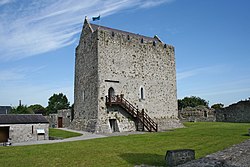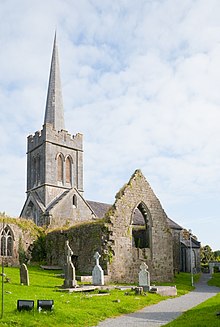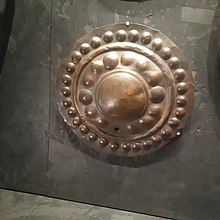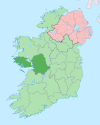Athenry
Athenry
Baile Átha an Rí | |
|---|---|
Town | |
 | |
| Coordinates:53°18′00″N8°44′46″W/ 53.300°N 8.746°W | |
| Country | Ireland |
| Province | Connacht |
| County | County Galway |
| Elevation | 47 m (154 ft) |
| Population (2022)[1] | 4,603 |
| Time zone | UTC±0(WET) |
| • Summer (DST) | UTC+1(IST) |
| Eircoderouting key | H65 |
| Telephone area code | +353(0)91 |
| Irish Grid Reference | M500282 |
Athenry(/æθənˈraɪ/;[a]Irish:Baile Átha an Rí,meaning 'Town of the Ford of the King') is a town inCounty Galway,Ireland,which lies 25 kilometres (16 mi) east ofGalwaycity. Some of the attractions of the medieval town are its town wall,Athenry Castle,itsprioryand its 13th century street-plan. The town is also well known by virtue of the song "The Fields of Athenry".
History[edit]

| Year | Pop. | ±% |
|---|---|---|
| 1821 | 1,093 | — |
| 1831 | 1,319 | +20.7% |
| 1841 | 1,236 | −6.3% |
| 1851 | 1,487 | +20.3% |
| 1861 | 1,283 | −13.7% |
| 1871 | 1,194 | −6.9% |
| 1881 | 1,030 | −13.7% |
| 1891 | 910 | −11.7% |
| 1901 | 853 | −6.3% |
| 1911 | 791 | −7.3% |
| 1926 | 993 | +25.5% |
| 1936 | 1,048 | +5.5% |
| 1946 | 1,153 | +10.0% |
| 1951 | 1,181 | +2.4% |
| 1956 | 1,287 | +9.0% |
| 1961 | 1,266 | −1.6% |
| 1966 | 1,333 | +5.3% |
| 1971 | 1,240 | −7.0% |
| 1981 | 1,479 | +19.3% |
| 1986 | 1,642 | +11.0% |
| 1991 | 1,612 | −1.8% |
| 1996 | 1,614 | +0.1% |
| 2002 | 2,154 | +33.5% |
| 2006 | 3,205 | +48.8% |
| 2011 | 3,950 | +23.2% |
| 2016 | 4,445 | +12.5% |
| 2022 | 4,603 | +3.6% |
| [1][2][3][4] | ||
Athenry's name derives from the ford ('Áth') crossing the river Clarin just east of the settlement. It was originally called 'Áth na Ríogh' ('Ford of the Kings') because it was the home area of the Cenél nDéigill kings ofSoghan,whose leading lineage were the Ó Mainnín.[5]On some medieval maps of English origin the town is called Kingstown.
Originally, Soghan was surrounded byUí Maineto the east,Aidhneto the south, andMaigh Seolato the west. However, after 1135, and by 1152,Tairrdelbach Ua Conchobairforcibly incorporated it into the newly createdtrícha cétofClann Taidg,ruled by lords such asFearghal Ó Taidg an Teaghlaigh,who expelled the Ó Mainnín family. In the 1230s the Ó Taidg an Teaghlaigh family were in turn displaced byMeyler de Bermingham.[5]
The earliest remaining building in the town isAthenry Castlewhich was built sometime before 1240 byMeyler de Bermingham.In 1241, theDominicanPriory was founded, and became an important center for learning and teaching. It was ostensibly closed during theProtestant Reformationbut survived until being desecrated and burned during the Mac an Iarla wars of the 1560s–80s, and was finally vandalised by Cromwellians in the 1650s. The medieval walls around Athenry are among the most complete and best preserved in Ireland with 70% of original circuit still standing, along with some of the original towers and the original North gate.[6]The remains of the Lorro Gate were partially unearthed in 2007 during the redevelopment of road works in the area.
In the centre of the town is the 'square'; markets were held from the 17th century onwards and where the town's late 15th century 'Market Cross' is still located. The monument which is ofTabernacleorLanterntype is the only one of its kind in Ireland and the only medieval cross still standing in situ in the country.[7]A Heritage centre now occupies the remains of the mid-13th century St Mary'sCollegiate Churchadjacent to the town Square. The original medieval church is largely destroyed but in 1828 aChurch of Irelandchurch was built into its chancel.

In 1791,Jean Antoine Coquebert de Montbretvisited the town, which he described as:
It covers 50 acres but has not more than 60 houses. [...] There isan abbeyof which the ruins are almost all standing. There is a big uninhabited castle called Bermingham's Court [...]. In the middle of Athenry is the stump of a cross destroyed in the wars, on which acrucifixinbas-reliefstill remains. [...] I noticed at the door of a tavern a large cake decorated with a bouquet. It was a prize for the best dancer. [...] The road from Athenry is very beautiful and there are no barriers.
Moyode Castle is another tall 16th-century fortifiedtower houseof the Dolphin family, which went to the Persse family. The castle is now restored and inhabited and is located 3.5 miles (5.6 km) from the town of Athenry.
In 1863, a lateBronze Ageshield was found in the vicinity of Athenry, and is now held in theBritish Museum's collection.[9]
Economy and transport[edit]

Transport[edit]
By road, Athenry is served by theM6 motorwaywhich links Galway city toDublin.By rail, it is served by theAthenry railway station,which opened on 1 August 1851 and lies on the Galway–Dublin main line of theIrish rail network.The town is at thejunctionof the Galway–Dublin line, and the partially complete theWestern Railway Corridor(Limerick–Sligo).
Industry[edit]
In December 2017, funding was announced for a "Food Innovation Hub" in Athenry, projected by its promoters to create 360 jobs within 3 years, and to cost in the region of €3.9m.[10]

Sport[edit]
Athenry is home to theGaelic Athletic AssociationSt. Mary Club,[11]which has won threeAll-Ireland Senior Club Hurling Championshiptitles.
Athenry Athletics Club has a juvenile and a senior section.[12][13]The club has produced twoOlympicsprinters, Martina McCarthy andPaul Hession.[14][15]McCarthy represented Ireland in thewomen's 4 × 400 metres relayat the2000 Summer Olympicsand Hession competed in themen's 200 metresat the2008 Summer Olympics.
Athenry is also home to Athenry F.C., founded in 1971.[16]The club reached the 2006 final of theFAI Junior Cup,[17]and the following year it became theGalway & District Leaguechampions for the first time, repeating the same achievement during the 2007–08, 2009–10, and 2014–15 seasons.[18]In 2007, 2008, 2009, 2011 and 2016, Athenry also won theConnacht Junior Cuptitle.[18]
Athenry is also home of the Athenry Golf Club and Athenry Judo Club.[19][20]
International relations[edit]
Twin towns – Sister cities[edit]
Athenry istwinnedwith the town ofQuimperléinBrittany(France) and, since 2013,Renews-Cappahayden,Newfoundland and Labrador(Canada).[21][22]
People[edit]
The following is a list of notable natives of Athenry:
- Slim Barrett(born in the 1960s) – award-winning jewellery designer and artist;
- Anthony Richard Blake(1786–1849) – lawyer, administrator and 'backstairsViceroy of Ireland';
- Robert Blakeney(1679–1733) –Member of Parliamentfor Athenry;
- Tomás Bobhdacing(fl. c. 1300) – founder of theBodkinfamily;
- Noël Browne(1915–1997) – doctor and politician;
- Dominic Burke(c. 1603–1649) –Dominicanpriestand political agent;
- John de Burgh(1590–1667) –Archbishop of Tuam;
- Micheál de Búrc(c.1800 – 6 July 1881) – poet;
- Oliver Burke(c. 1598–1672) –Bishop of Kilmacduagh;
- Thomas Burke(c. 1747–1783) – governor ofNorth Carolina;
- William Burke(c. 1611–dead by 1685) – Dominican cleric and prior;
- James Patrick Broderick(1891–1973) – Jesuit and religious writer;
- Conainne(fl.c. 500) – Christian missionary;
- Ciarán Cannon(born 1965) –Fine GaelTeachta Dála(TD) for theGalway Eastconstituency;
- Eugene Cloonan(born 1978) –hurler;
- John Cummings(1828-after 1913) – piper;
- Patrick D'Arcy(1598–1668) – writer of the constitution ofConfederate Ireland;
- Vincent Dillon(died 1651) –Dominicanmartyr;
- Basilia de Bermingham(fl. c. 1250) – religious patron;
- Meyler de Bermingham– founder of Athenry;
- Rickard de Bermingham(died 1322) – lord of Athenry;
- Liam Deois(fl. early 1800s) –highwayman;
- Padraic Fallon(1905–1974) – poet and playwright;
- Elaine Feeney(born 1979) – poet;
- Julie Feeney(born 1979) – singer and composer;
- Robert French(1716–1779) –MPand landlord;
- Fearghal Ó Taidg an Teaghlaigh(died 1226) –marshalto thekings of Connacht;
- Paul Hession(born 1983) –track and fieldathlete;
- Kerrill(fl. c. 480) – Christian missionary;
- Nannie Lambert Power O'Donoghue(1843–12 January 1940) – poet, journalist,equestrian;
- Larry Lardner(fl. 1920) –IRAcommander;
- Mary Lavin(1912–1996) – writer and novelist;
- Bryan Mahon(1862–1930) – general of theBritish Armyand Senator of theIrish Free State;
- Maél Póil(fl. c. 800s–900s) – medieval abbot of Templemoyle;
- P. J. Molloy(born 1952) – hurler;
- Marcas Ó Callanáin(1784–1836) – poet and balladier;
- Tom O'Connor– local historian;
- John O'Heyne(c. 1648–1713) – historian andDominican;
- Joe Rabbitte(born 1970) – hurler;
- Frank Shawe-Taylor(1869–1920) –High Sheriff of County Galway,killed during theIrish War of Independence;
- Brian Shawe-Taylor(1915–1999) – racing driver;
See also[edit]
- Battle of Maigh Mucruimhe
- Baron Athenry
- First Battle of Athenry
- Second Battle of Athenry
- The Sack of Athenry
- The Fields of Athenry
- Nevin (surname)
- List of abbeys and priories in Ireland (County Galway)
- List of towns and villages in Ireland
Note[edit]
References[edit]
- ^ab"Profile 1 - Population Distribution and Movement F1015 - Population: Athenry, Co. Galway".Central Statistics Office (Ireland).Retrieved21 July2023.
- ^"Histpop — The Online Historical Population Reports Project".HistPop.org.Retrieved26 April2017.
- ^Lee, John Joseph(1981). "On the accuracy of thepre-famineIrish censuses ". In Connell, Kenneth Hugh; Goldstrom, J. M.; Clarkson, Leslie A. (eds.).Irish population, economy, and society: Essays in honour of the late K.H. Connell.Oxford, England: Clarendon Press. pp. 37–56.
- ^Mokyr, Joel;Ó Gráda, Cormac(1984). "New developments in Irish population history, 1700-1850".The Economic History Review.37(4): 473–488.doi:10.1111/j.1468-0289.1984.tb00344.x.hdl:10197/1406.
- ^ab"The Mannion Clan".MannionClan.org.Retrieved10 April2017.
- ^Rynne, Etienne (1992).Athenry: A Medieval Irish town.Athenry Historical Society.ISBN978-0716524748.
- ^Thomas, Avril (1992).The walled towns of Ireland.Irish Academic Press.ASINB00382S42I.
- ^Ní Chinnéide, Síle (1952). "Coquebert de Montbret's: Impressions of Galway City and County in the year 1791".Journal of the Galway Archaeological and Historical Society.25(1/2): 1–14.ISSN0332-415X.OCLC5557175705.
- ^"Museum number 1888,0719.1 - Shield".British Museum Collection.Retrieved19 October2020.
- ^Siggins, Lorna; Hamilton, Peter (11 December 2017)."Athenry gets €4.5m food innovation campus as Apple 'in limbo'".The Irish Times.Retrieved30 May2018.
- ^"St. Mary GAA Club Athenry official website".Athenrygaa.it.Retrieved5 May2017.
- ^"Athenry AC Juvenile Contact Information".AthenryAC.Archived fromthe originalon 7 June 2017.Retrieved7 June2017.
- ^"Athenry AC (Senior) 10th Anniversary - some thoughts and numbers".AthenryAC.December 2012.Archivedfrom the original on 7 June 2017.Retrieved7 June2017.
- ^"Martina Medals at AAI Games".AthenryAC.18 May 2009.Archivedfrom the original on 7 May 2017.Retrieved7 May2017.
- ^"Good Luck Paul Hession".AthenryAC.20 August 2007.Archivedfrom the original on 7 May 2017.Retrieved7 May2017.
- ^"Athenry FC History".AthenrySoccerClub.ie.Archivedfrom the original on 29 May 2017.Retrieved29 May2017.
- ^"FAI Junior Cup 2006".FAI.it.Football Association of Ireland.Archived fromthe originalon 5 October 2006.Retrieved5 October2006.
- ^ab"Athenry Football Club Roll of Honor".AthenrySoccerClub.ie.Archivedfrom the original on 29 May 2017.Retrieved29 May2017.
- ^"History of Athenry Golf Club".AthenryGolfClub.net.Archivedfrom the original on 28 October 2017.Retrieved28 October2017.
- ^"Athenry Judo Club".AthenryJudoClub.Retrieved28 October2017.
- ^"Jumelage Quimperlé-Athenry: Pâques en Irlande".Le Télégramme(in French). 12 February 2007.Archivedfrom the original on 12 June 2017.Retrieved12 June2017.
- ^"Athenry twinned with Newfoundland town".Galway Advertiser.5 September 2013.Archivedfrom the original on 12 June 2017.Retrieved12 June2017.
Further reading[edit]
- Blake, Martin J. (1902). "The abbey of Athenry".Journal of the Galway Archaeological and Historical Society.2(2): 65–90.
- Browne, Paul (2003).Eagles over Ireland.Paul Browne and the Flying Fortress 1943 Project (2003).
- Cody, Eamon (1989).An archaeological survey of the Barony of Athenry, County Galway(PhD). National University of Ireland, Galway.
- Finnerty, Martin (1951).Punann Arsa: The story of Athenry, Co. Galway.ASINB0007JU37E.
- Finnerty, Martin (1951).Punann Arsa: The story of Athenry, Co. Galway.Ballinasloe:The Author.OCLC19053582.
- John., Givens (2008).Irish walled towns.Dublin: Liffey Press.ISBN978-1905785261.OCLC190966333.
- Holland, Patrick (1997). "The Anglo-Norman landscape in County Galway; Land-holdings, castles and settlements".Journal of the Galway Archaeological and Historical Society.49:159–193.
- Healy, Ann (1989).Athenry: A brief history and guide.Athenry: A. Healy.OCLC25247772.
- Jordan, Kieran (2000).Kiltullagh/Killimordaly as the centuries passed: A history from 1500–1900.Kiltullagh/Killimordaly Historical Society.ISBN978-0953868407.OCLC47658628.
- Macalister, Robert Alexander Stewart(1913). "The Dominican Church at Athenry".The Journal of the Royal Society of Antiquaries of Ireland.3(3): 197–222.ISSN0035-9106.OCLC5557091173.
- MacCarthy, Bartholomew; Hennessy, William Maunsell; O'Cassidy, Rory; Maguire, Cathal MacMaghnusa; Royal Irish Academy (1887–1901).Annala Uladh: Annals of Ulster otherwise Annala Senait, Annals of Senat: a chronicle of Irish affairs from A.D. 431 to A.D. 1540.Dublin: Printed for H. M. Stationery off., by A. Thom & co.
- McNeill, Charles (1920). "Remarks on the walls and church of Athenry".Journal of the Galway Archaeological and Historical.11(34): 132–141.
- O'Connor, Tom (2003).Turoe and Athenry: Ancient capitals of Celtic Ireland.Cork: Tom O'Connor.ISBN978-0954487508.OCLC53156104.
- O'Regan, Finbarr, ed. (1999).The Lamberts of Athenry: A book on the Lambert families of Castle Lambert and Castle Ellen, Co. Galway.Athenry: Finbarr O'Regan for Lambert Project Society.OCLC605967315.
- Papazian, Cliona; Collins, Brenda; McCarthy, Margaret (1991). "Excavations at Athenry Castle, Co. Galway".Journal of the Galway Archaeological and Historical Society.43:1–45.ISSN0332-415X.OCLC5557085297.
- Roy, James Charles (2008).The Fields of Athenry: A journey through Irish history.Boulder, CO: Basic Books.ISBN9780786742547.OCLC817927632.
- Rynne, Etienne (1992).Athenry: A medieval Irish town.Athenry: Athenry Historical Society.OCLC26764288.
- Sheehy, Maurice P. (1964). "The Parish of Athenry in 1434".Journal of the Galway Archaeological and Historical Society.31(1/2): 8–10.ISSN0332-415X.OCLC5557173255.
- Walsh, Anne (1996). "Smallpox in Athenry, 1875".Journal of the Galway Archaeological and Historical Society.48:143–152.OCLC538306019.


